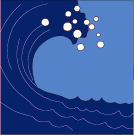
CDP Unit
on the Galapagos Islands
No Freshwater?

Unit Topic: The Galapagos Islands
Grade Level: Middle School
Basic Concepts: Creative thinking and calculating, freshwater usage, conservation, fractions.
Content Area: Mathematics, Language Arts, Science
Time: 3 hours
Rational: Many times in the Bishop's letter (day 1) and throughout the literature circle books that are used with this unit, there are countless entries that tell of a shortage of freshwater. This lesson plan was devised to make the students aware of the freshwater that they use every day, most of the time without even thinking about it.
Objectives
This lesson will give the students an opportunity to see how valuable freshwater really is. It also allows them to see "hands on" how much freshwater they themselves use on a daily basis.
Activity 1
Discuss with the students what would happen if freshwater was not readily available, as this occurs in many of the books that are recommended for this CDP. Talk about ways drinking water is wasted and how it can be conserved. Through experimentation, have the students calculate how much water they use to brush their teeth. Then have the student keep track of how much water they use throughout the day.
Materials: Chart attached, Guide sheets students should bring in their toothbrushes and toothpaste, pencil, paper
Activity 2
After students have realized the importance of fresh water and collected the data from a days waste of water, have them share their answers. Next, the students should tabulate their answers and then compile the following answers to the questions:
-What is the class average use of freshwater in a day?
-Who uses the least amount of water during the day? Compare this persons results to those of your own using fractions.
-Who uses the most water during the day? Compare this persons results to those of your own using fractions.
-Compute your usage of water for a whole week, month, year.
Materials: Paper, information gathered by the students, pencils
Activity 3
Have the students write in their journals about how important they see the need for freshwater. Have them relate their concern for freshwater to the characters in their books that are going through crisis without freshwater. Ask them to write a short solution to how they would handle a water shortage problem?
Materials: journals, pencils
Activity 4
Have the students pair up and talk about how they would solve the problem of a water shortage. After they have discussed how they might approach the problem, have them try to construct a device that has the ability to collect freshwater from nature in the setting that they are placed in, as some of the characters in the unit books might have had to. These structures will be presented to the class to see just how much one of the students structures can collect of freshwater. Constructing materials for the water collectors can be limited to small amounts like the characters in the books were faced with.
Materials: Various materials for constructing the water collectors (tubes, aluminum foil, etc.)
Assessment: The teacher can assess the students by their results. Of course the answers will all be different but look at the process. To be successful, a student must achieve a 5 on the observation rubric, and a 12 on the Project rubric.